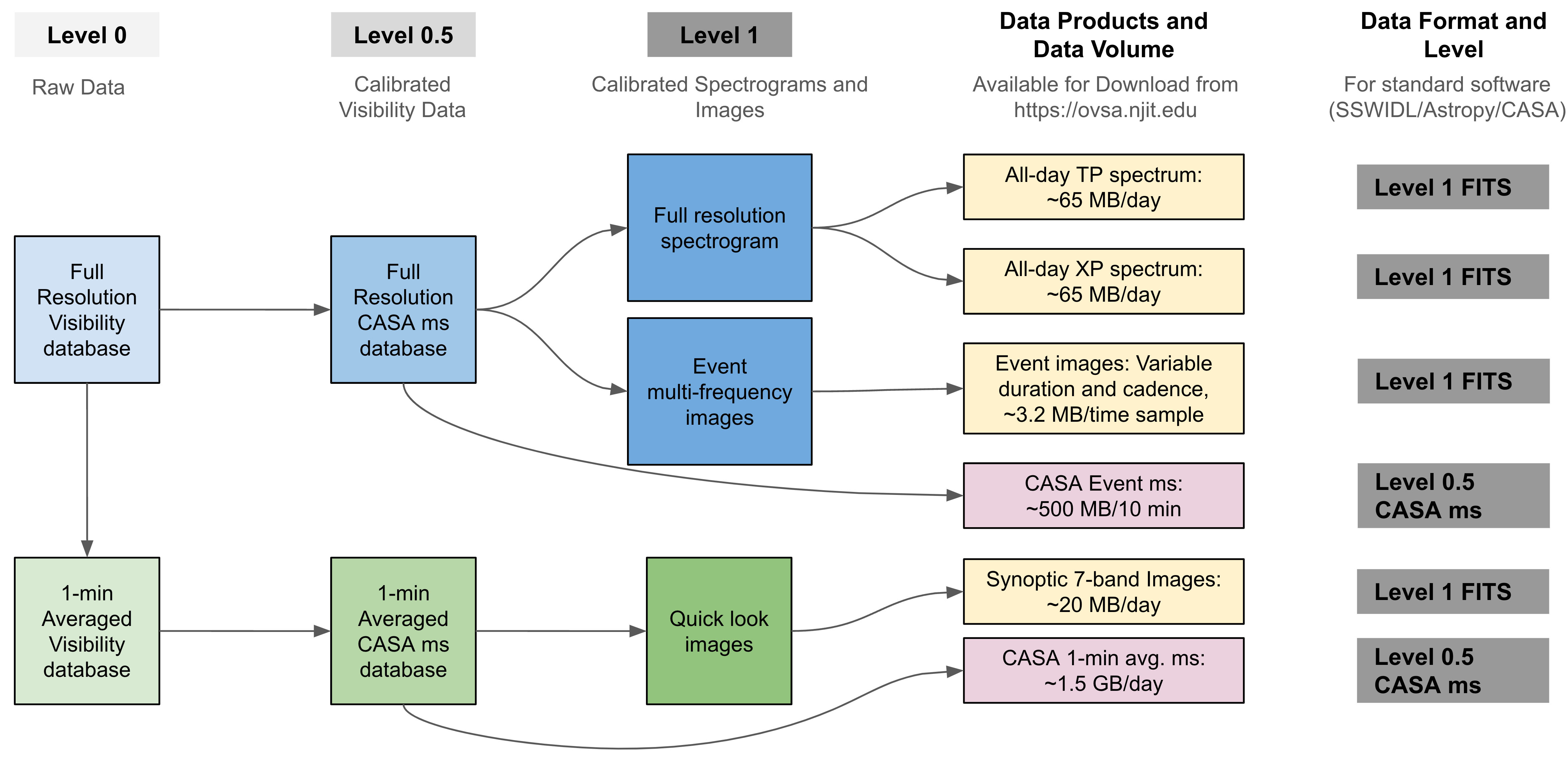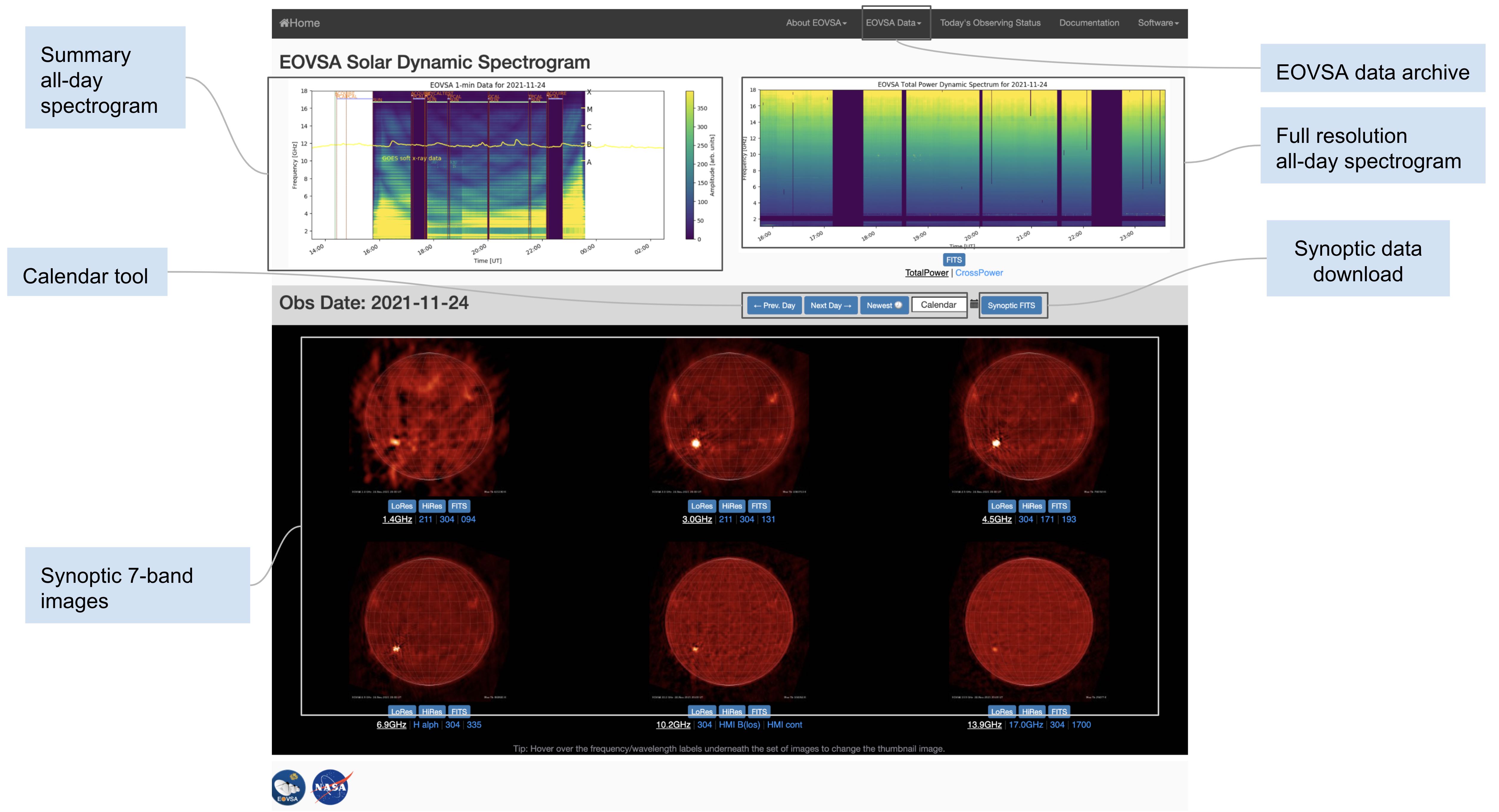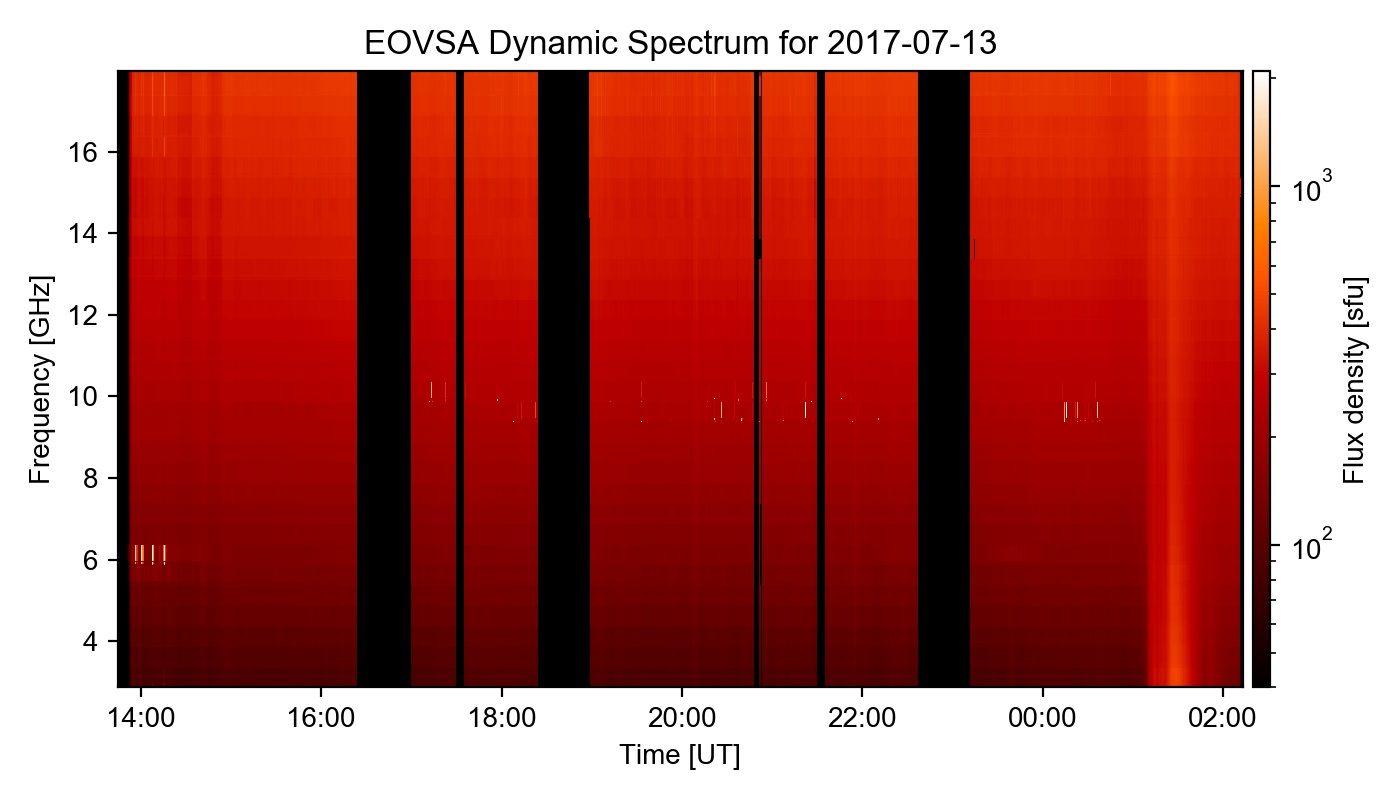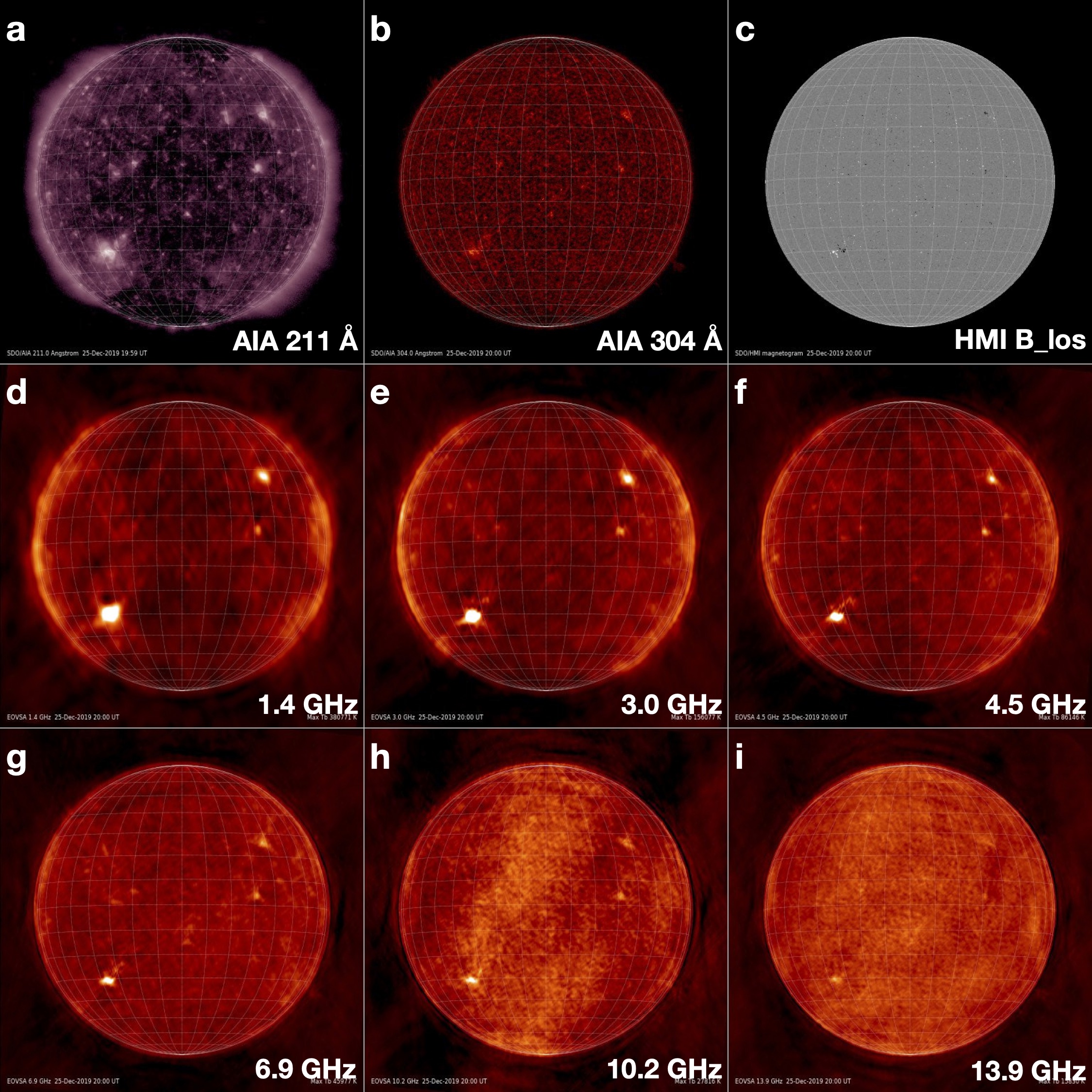EOVSA Data Products
Welcome to the EOVSA data products documentation. EOVSA observes the full disk of the Sun at all times when the Sun is >10 degrees above the local horizon, which is season dependent and ranges from 7-12 hours duration centered on 20 UT. During January, coverage will be 16-24 UT daily, 7 days/week. Like any radio interferometer, the fundamental measurement for imaging is the correlated amplitude and phase between each pair of antennas, which is called a “complex visibility.” EOVSA’s 13 antennas form 78 such visibilities at any frequency and instant of time, i.e. 78 measurements of the spatial Fourier transform of the solar brightness distribution. EOVSA records these visibilities at 451 science frequency channels each second, in four polarization products, as well as additional total flux measurements from each individual antenna. These data are then processed through a pipeline processing system (the block diagram in Figure 1 shows the data flow in the pipeline). One of the outputs of the pipeline is a visibility database in a widely used open-standard format called a CASA measurement set (or “ms”; CASA is the Common Astronomy Software Applications package used by many modern interferometer arrays). Many different CASA ms’s can be created from the raw visibility data by selecting time ranges, frequencies, integration times, polarizations, and so on.
We deliver the radio interferometry data on the following three levels:
Level 0 - Raw visibility data from the instrument
As outlined in Figure 1, the real-time pipeline creates raw data products in the left-hand column (labeled Level 0). This includes observations of cosmic sources for phase calibration, and gain and pointing observations required for total power calibration.
raw full resolution visibility database
EOVSA full resolution visibility database can be retrieved from the following page:
http://www.ovsa.njit.edu/fits//IDB/
raw 1-min averaged visibility database
EOVSA 1-min averaged visibility database can be retrieved from the following page:
http://www.ovsa.njit.edu/fits/UDB/
Level 1 - calibrated visibility data
After applying calibration and other preliminary processing to level 0 data, we create the CASA ms’s in the second column in Figure 1 ( labeled Level 1). These visibility data have all of the required content to produce Level 2 images and spectrogram data in standard FITS format. We provide a set of standard ms’s for each day (red boxes in Figure 1), for use by researchers who wish to start with visibility data.
CASA Event ms
EOVSA event data products in boxes with dashed outlines in Figure 1 will typically be available within 30 days after they are taken.
Link: TBD.
CASA 1-min averaged ms
EOVSA 1-min averaged visibility data in CASA ms format can be retrieved from the following page:
http://www.ovsa.njit.edu/fits/UDBms_slfcaled
Level 2 - Images and spectrogram data in standard FITS format
Most users, however, will prefer to work with spectrogram (frequency-time) and image data, which are also outputs of the pipeline system shown in Figure 1 (orange boxes). Spectrograms are provided as standard FITS tables containing the frequency list, list of times, and data in both total power and a sum of amplitudes over intermediate-length baselines (cross power). Likewise, image data products are in FITS format with standard keywords and are converted into the Helioprojective Cartesian coordinate system compatible with the World Coordinate System (WCS) convention, along with correct registration for the spatial, spectral, and temporal coordinates. Both the spectrogram and image data products are calibrated properly and have physical radio intensity units (sfu for spectrograms and brightness temperature for radio images).
List of Level 2 data products
| category | data product | name |
|---|---|---|
| Dynamic Spectrum | All-day TP spectrum | EOVSA_TPall_yyyymmdd.fts |
| All-day XP spectrum | EOVSA_XPall_yyyymmdd.fts | |
| Image | ||
| Synoptic 1.4 GHz image | eovsa_yyyymmdd.spw00-01.tb.disk.fits | |
| Synoptic 3.0 GHz image | eovsa_yyyymmdd.spw02-05.tb.disk.fits | |
| Synoptic 4.5 GHz image | eovsa_yyyymmdd.spw06-10.tb.disk.fits | |
| Synoptic 6.8 GHz image | eovsa_yyyymmdd.spw11-20.tb.disk.fits | |
| Synoptic 10.2 GHz image | eovsa_yyyymmdd.spw21-30.tb.disk.fits | |
| Synoptic 13.9 GHz image | eovsa_yyyymmdd.spw31-43.tb.disk.fits |
Getting level 2 data
EOVSA Level 2 data products can be retrieved with the following steps:
- go to EOVSA browser page.
- Browse to the date of interest.
- Click "synoptic fits" button next to the calendar tool.
- Select the data product based on the names listed in the table above.
Reading level 2 data
Software
We have developed a package for EOVSA data processing and analysis: SunCASA A wrapper around CASA (the Common Astronomy Software Applications package) for synthesis imaging and visualizing solar spectral imaging data. CASA is one of the leading software tools for "supporting the data post-processing needs of the next generation of radio astronomical telescopes such as ALMA and VLA", an international effort led by the National Radio Astronomy Observatory. The current version of CASA uses Python (2.7) interface. More information about CASA can be found on NRAO's CASA website . Note, CASA is available ONLY on UNIX-BASED PLATFORMS (and therefore, so is SunCASA). We are developing a new version of SunCASA based on CASA 6 (which offers a modular approach) so that users have the flexibility to build CASA tools and tasks in their Python environment.
Please follow this link for details regarding the installation of SunCASA on your own machine (only available on Unix-bases OS). This will take you to another page.
All-day TP spectrum
Daily total power full-Sun-integrated spectrogram calibrated in solar flux units are provided at 451 frequencies (134 frequencies prior to 2019 Feb 22) and 1 s time resolution.
To read a spectrogram file in Python using the suncasa library:
from suncasa.eovsa import eovsa_dspec as ds from astropy.time import Time from matplotlib.colors import LogNorm ## Read EOVSA Dynamic Spectrum FITS file <filename> filename = 'EOVSA_TPall_20170713.fts' s = ds.get_dspec(filename, doplot=True, cmap='gist_heat', norm=LogNorm(vmax=2.1e3, vmin=40)) ## To access the data in the spectrogram object, use spec = s['spectrogram'] ## (Array of amplitudes in SFU, of size nfreq,ntimes) fghz = s['spectrum_axis'] ## (Array of frequencies in GHz, of size nfreq) tim = Time(s['time_axis'], format='mjd') ## (Array of UT times in astropy.time object, of size ntimes)
The "get_dspec" code is available in suncasa.
The following code will read the spectrogram file in IDL:
function dspec,filename,doplot=doplot
; Read EOVSA Dynamic Spectrum FITS file <filename> and return a spectrogram object.
; Optionally show an overview plot if doplot switch is set
;
; Usage:
; s = dspec(<filename>) ; Returns spectrogram object
; s = dspec(<filename>,/doplot) ; Plots spectrum and returns spectrogram object
;
; To access the data in the spectrogram object, use
; spec = s.get(/spectrogram) (Array of amplitudes in SFU, of size ntimes, nfreq)
; fghz = s.get(/spectrum_axis) (Array of frequencies in GHz, of size nfreq)
; ut = s.set(/time_axis) (Array of UT times in anytim format, of size ntimes)
default,doplot,0
spec = mrdfits(filename,0)
freq = mrdfits(filename,1)
time = mrdfits(filename,2)
fghz = freq.sfreq
ut = anytim(time)
s = spectrogram(spec,ut,fghz)
if doplot then begin
window,/free,xsiz=1024,ysiz=600
; Find min and max of data from 5% to 95% of sorted array (eliminates outliers)
sarr = sort(spec)
dlim = minmax(spec[sarr[n_elements(sarr)*0.05:n_elements(sarr)*0.95]])
; Set drange with margin factor of 2 on low end and 5 on high end
s.set,drange=dlim*[0.5,5]
loadct,3
s.plot,/log,/xsty,/ysty,ytitle='Frequency [GHz]',charsize=1.5
endif
return,s
end
Synoptic 6-band Images
Full disk images at 6 selected frequency bands centered at 1.4, 3.0, 4.5, 6.8, 10.2, and 13.9 GHz are provided once per day, calibrated in brightness temperature.




